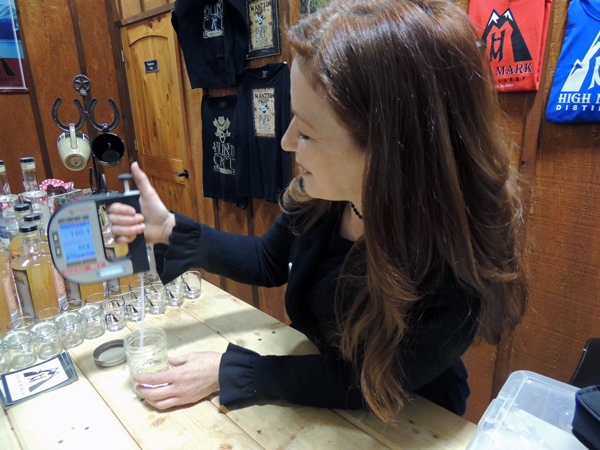
Tucked a few miles off the highway in Sterling is one of the newest players in the burgeoning Alaskan craft spirits industry.
“Would you like a hot toddy?” was the friendly greeting I got when I walked into the tasting room at the High Mark Distillery.
“Of course.”
It was after noon and snowing. Seemed appropriate.
Owner Felicia Keith-Jones started her venture five years ago, but she didn’t initially plan on producing her own libations. She was working with a group in the Mat-Su Valley to develop bio-fuels, but that endeavor ran out of gas.
“The big dogs did not wish for us to have biodiesel in this state. We were studying for three years, and then my husband mentioned that if you remove three steps and add wheat, what have you got? Vodka. And that truly was the family joke,” Jones said.
After her husband passed away five years ago, she took a break from teaching to see if the family joke could become the family business.
“What if? What if I did make vodka? Because I already had the education for it. What if I did pursue this?”
A chance meeting in Bethel led her and her boys to Ireland, where they know a thing or two about turning grain and water into something more interesting.
“When I got back to Alaska, I knew, absolutely knew, that this was the path I wanted to take because it was one of the few things that absolutely every day made you smile. The challenges were huge, and once I had my first batch, I smiled,” she said with a laugh.
And High Mark’s signature vodka was born. Since then, Jones has adapted old-world recipes for the popular Nickel Back Apple Jack and a corn liquor she calls Blind Cat. Since wheat, apples and corn aren’t exactly signature Alaskan crops, Jones sources them from Washington.
“The orchard that grows for us also grows for Gerber farms. So with the corn and the apples, we decided if it was good enough for babies, it was good enough for us.”
High Mark uses spring white wheat as the base grain for its vodka.
Now, you can have all the knowledge and the best ingredients in the world, but that’s still no guarantee that what you pour is going to be any good. The key to making quality, consistent spirits is doing it in small batches with a lot of attention.
“When I say that it’s a gamble every single time, the truth is, if you don’t take absolutely beautiful notes and write down everything you put in to one of these, you can’t duplicate it. So, you might end up with rot-gut and you might end up with just the recipe you were hoping for. So you’ll test it every few weeks to record how it’s maturing.”
It’s not just the whiskey that’s maturing. High Mark’s one year anniversary is this month. And Jones says there are plans for growth and new products. The Blind Cat moonshine is just one step away from becoming a bourbon. Just pour it into a barrel and wait. That new spirit will demand a new position at the distillery.
“The worst job you can have at a distillery is to be the bunghole checker,” Jones jokes.
“Once the barrels are all into the barrel house, they have to be rotated because when you fill them, you do end up with a tiny air bubble. So that top layer of bourbon would not react with the wood, so you have to rotate your barrels and check your bung,” she says, trying not to crack up again. The only thing that might be more plentiful than the spirits here is the laughs.
Over the past year, High Mark has become at least a semi-regular stop for neighbors. The nearby lodges on the Kenai River also bring in customers. When I dropped by on a recent Saturday, I met Karen von Breyman. She lives just down the road. She’d seen the signs for the new place all last winter.
“We have lots of friends who come in the summer to fish and hang out, and we discovered that it was 1,400 yards, so we could just walk up the hill. So we walked and we tasted, and it was a good thing we walked, and then we giggled all the way home,” von Breyman said. “I don’t know why I’m so excited about it, I just think it’s a fascinating story and a business. I’m not even a big drinker, but I just think it’s wonderful.”
Shaylon Cochran is a host and reporter at KDLL in Kenai. He’s reported on fishing, energy, agriculture and local politics since coming to Alaska in 2011. He has worked at KDLL/KBBI on the Kenai Peninsula, where he picked up lots of new hobbies, like smoking salmon, raising chickens, skiing and counting RV’s. He holds a bachelors degree in Journalism from Iowa State University.




